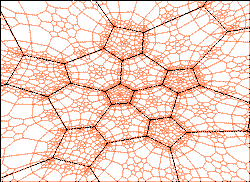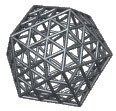|
|
|
Some remarks (3)
22. This is a nice simplified image of a T2 tube. In our case the purple tube will be however double layered with an extra graviton membrane that stretches over the blue tube. To have this result there were two possible pelastrations: (1) the blue tube pelastrated the purple tube, and (2) the blue tube pelastrated in the purple tube.

23. When a micro-tube-zone hits a larger tube-zone with rigid skin-layers the micro-tube will need to drill (increasing point-tension and spinning tube).
24. Interesting is also to note that two graviton membranes are - after a pelastration - pressed together. Since each graviton membrane pulls (attract) directional on his inside particles and objects we have a strange problem. How does spin 2 reacts? ;-) Or even ... can there be original ZERO between membranes?
25.The Graviton membrane (GM) is in our theory unbreakable and infinite elastic. It is the only concept that forefills a number of parameters: actief present in every single 'element' in the cosmos, very simple concept, pulling from the inside, invisible, etc. The initial structure is today not definite understood but a membrane based on triangle-based shapes is evident to me. The Graviton membrane and US [the (w)hole content] are the result of movement. Since the gravitons are only pulling, the center is only pushing. With pelastration this pushing is segmented in self-fixing combinations. Fixation points. The basic fixation points may be geometeric positioned. By the pelastration mechanism the gravition membrane is present in every single fixed multi-layer complex, as there is a part of the original pushing force too but.
 |
|
|
| A fractal Buckyball 5-6 approach |
|
The powerfull icosahedron |
24. Singularity: a point or region of infinite mass density at which space and time are infinitely distorted by gravitational forces and which is held to be the final state of matter falling into a black hole. Does this resembles to a tube pelastration?
25. The paradox of the Big Tube theory is that the center(s) and the membrane(s) of each tube-zone are still part of the same original T1 center and membrane. Now an other paradox is that we 'see' others and objects as separate unities because of their "layers", but in fact we are connected in many ways on sub-levels but also via the basic source. What we believe to see in others and objects is only a multi-layered and temporary fixed representation of US all. So this world is what some call the MAYA. Now VOID tubes - with in the center part of the Void - are also possible under certain conditions.
|
|
|
|
26. Knowledge is based on also part of specific micro-tubes |
|
27. Recapitulation: My starting points:
0. Start: The Vector Equilibrium of Buckminster Fuller.
1. The gravitation field is an unbreakable elastic membrane, probably a triangle-shape tensegritic Bucky membrane. That's the GRAVITATION membrane.
2. Since gravitons only pull, the inside is only pushing (at the start).
3. Internal movements provoke the growth of giant tubes. They make 'snaking movements'.
4. Tube A hits Tube B and penetrates fully through Tube B.
5. Since the skin of Tube B can not break a part the dimension of tube B follows as a second skin Tube A during his trajectory.
6. A new dimension is created inside the second layer (skin) of TubeA.
7. On the Impact hole the two tubes push on each other thus making an type of pressure joint, a type of valve or worm-hole. A 'conditional' fixation of the new two dimensional layered structure happens. You might says that the pelastration has a discontinuing effect, creating a new type of entity (quality). This isolation creates an emanated new local spacetime geometry with unique parameters-settings (time, bending, pressure, ...) and a number of specific sub-tubes.
8. If conditions change de-pelastration can happen.
This process - which is not an euclidean manifold - goes on and on for millions of years and each dimension (sub-tube) is filled with all kind of variations of multi-layered tubes. The gravitation membrane is still in each sub-system present and also the original very center from the moment of creation.
I called that process: Pelastration (Penetration + Elastic + Stration = layers). I made a 10 page special website about this concept. There are different ways to pelastrate: Self-pelastration (Tube A through A), pelastration (Tube A through B), Partial pelastration (Tube C inserts between layers in Tube A), ....
In each sub-dimension the basic gravitation membrane is still there and also parts of the original pushing energy (since the center tube T1 can never be closed completely -> The total internal pressure of the whole system will lead to the finding of a universal constant value which the pelastration mechanism can not overcome).
Because the two tube-layers have friction and pressure interaction resonances starts.
Image: your body is the central tube and your clothes are the second 'visual' layer. When you move your arm the sleeve follows your arm repositioning. This movement creates a 'sound' provoke by the friction between skin and fabric (made by tiny fibers). That sound will be different if you wear cotton, wool, silk, nylon, etc.
So 'strings' have multi-layers which are isolated from each other.
The buildingblocs of our Universe are primary fermions and bosons. Bosons are called the messengers, which means that they are micro-tubes that pelastrate or catch the fermion-tubes and transport them to a locatation and then pull back leaving behind the fermion-tube connected with another fermion. You may compare it with the needle of a sewing-machine (bringing a string to another string or to a group of string [tissu].
|
|










